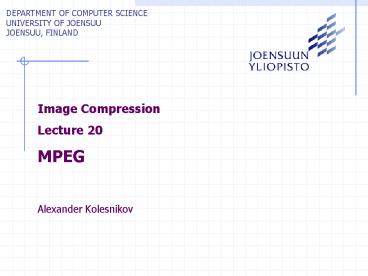Image Compression - PowerPoint PPT Presentation
1 / 15
Title:
Image Compression
Description:
Channel Bit rate 168 Mb/s 933 Mb/s 2300 Mb/s. PC LAN 30 kb/s 5,600:1 31,000:1 76,000:1 ... MPEGs. MPEG-1 (1992): VideoCD. MPEG-2 (1994): DVD, digital TV, SVCD ... – PowerPoint PPT presentation
Number of Views:44
Avg rating:3.0/5.0
Title: Image Compression
1
DEPARTMENT OF COMPUTER SCIENCE UNIVERSITY OF
JOENSUU JOENSUU, FINLAND
- Image Compression
- Lecture 20
- MPEG
- Alexander Kolesnikov
2
Video images compression ratios
NTSC TV HDTV Film quality Channel
Bit rate 168 Mb/s 933 Mb/s
2300 Mb/s PC LAN 30 kb/s 5,6001
31,0001 76,0001 Modems 56 kb/s
3,0001 17,0001 41,0001 ISDN
64 - 144 kb/s 1,1661 6,4001
16,0001 T-1, DSL 1.5 Mb/s
1121 6221
1,5001 Ethernet 10 Mb/s
171 931
2301 T-3 42 Mb/s
41 221
541 Fiber optic 200 Mb/s 11
51 111
3
Mideo Images and Still Images
- Video images are three-dimensional
generalization - of still images, where the third dimension is
time - Each frame of a video sequence can be compressed
by - any image compression algorithm
- Motion JPEG (M-JPEG) the images are separately
- coded by JPEG
4
Correlation
- Lets take an advantage of the temporal
correlations - i.e. the fact that subsequent images resemble
each - other very much
- Still Images spatial correlation
- Video Images spatial and temporal correlation
5
MPEG-1
- The MPEG algorithm relies on two basic techniques
- Block based motion compensation
- DCT based compression
6
MPEGs
- MPEG-1 (1992) VideoCD
- MPEG-2 (1994) DVD, digital TV, SVCD
- about 501 compression, typically 3-10 Mbps
- MPEG-3 was abandoned
- MPEG-4 (1999) DivX (starting from Version 5)
- designed specially for low-bandwidth
- MPEG-7 (gt1998)
- searching and indexing of a/v data, using
Description - Tools
7
MPEG-1 Blocks
- The pictures are divided into 16x16 macroblocks,
- each consisting of four 8x8 elementary blocks.
- The choice of the prediction method is chosen
for each - macroblock separately.
- The intra-coded blocks are quantized differently
from - the predicted blocks
- Intra-coded blocks contain information in all
frequencies - and are quantized differently from the
predicted blocks - The predicted blocks, contain mostly high
frequencies - and can be quantized with more coarse
quantization - tables.
8
MPEG-1 Inter-block Prediction
I
I
P
P
- Bidirectional prediction
- Forward prediction
- Backward prediction
- Intra coding.
9
MPEG-1 Predictions schemes
I Intra pictures are coded as still images by
DCT. P Predicted pictures are coded with
reference to a past picture. The difference
between the prediction and the original
picture is then compressed by DCT. B
Bidirectional pictures, the prediction can be
made both to a past and a future frame.
Bidirectional pictures are never used as
reference.
10
Motion estimation and compensation
- The prediction block in the reference frame is
not - necessarily in the same coordinates than the
block in - the current frame.
- Because of motion in the image sequence, the
most - suitable predictor for the current block may
exist - anywhere in the reference frame.
- The motion estimation specifies where the best
prediction - (best match) is found.
- Motion compensation consists of calculating the
difference - between the reference and the current block.
11
Motion estimation 1
- Exhaustive search block matching
Slow!
12
Motion estimation 2
- Hierarchical block matching
13
Compression ratios
NTSC TV HDTV Film quality Channel
Bit rate 168 Mb/s 933 Mb/s
2300 Mb/s PC LAN 30 kb/s 5,6001
31,0001 76,0001 Modems 56 kb/s
3,0001 17,0001 41,0001 ISDN
64 - 144 kb/s 1,1661 6,4001
16,0001 T-1, DSL 1.5 Mb/s
1121 6221
1,5001 Ethernet 10 Mb/s
171 931
2301 T-3 42 Mb/s
41 221
541 Fiber optic 200 Mb/s 11
51 111
14
Object-based coding
VOP- Video object plane VOL- Video object layer
15
Video content analysis
- Bring video sequence into chunks, each with
- consistent content shots
- Group similar shots into scenes
- Describe connections between scenes
- Associate shots/scenes with semantics for
future query































